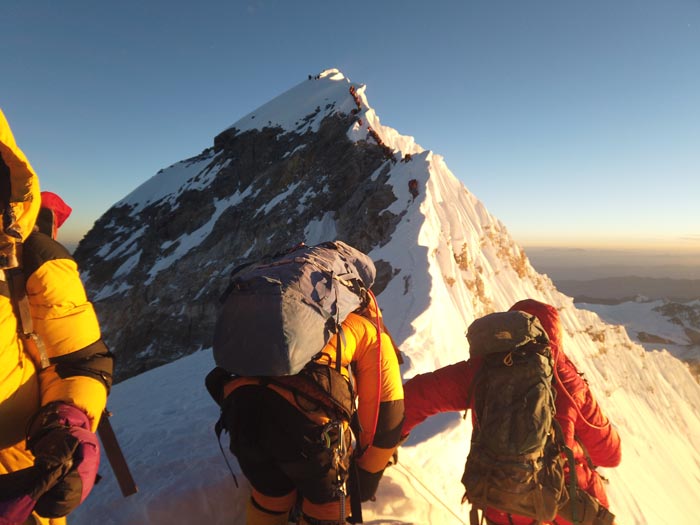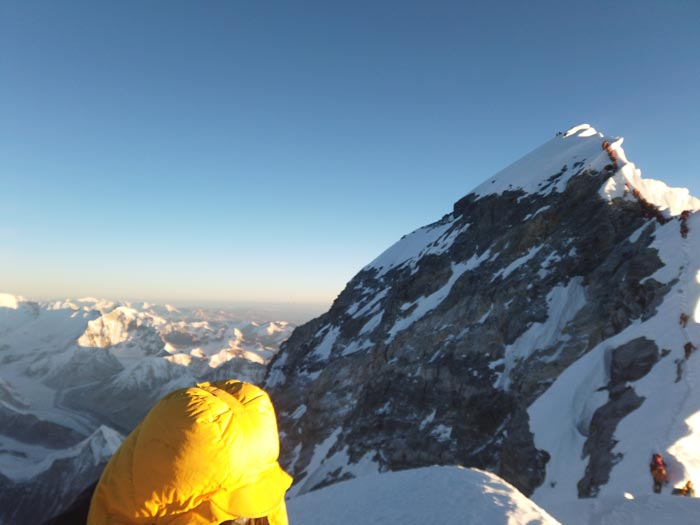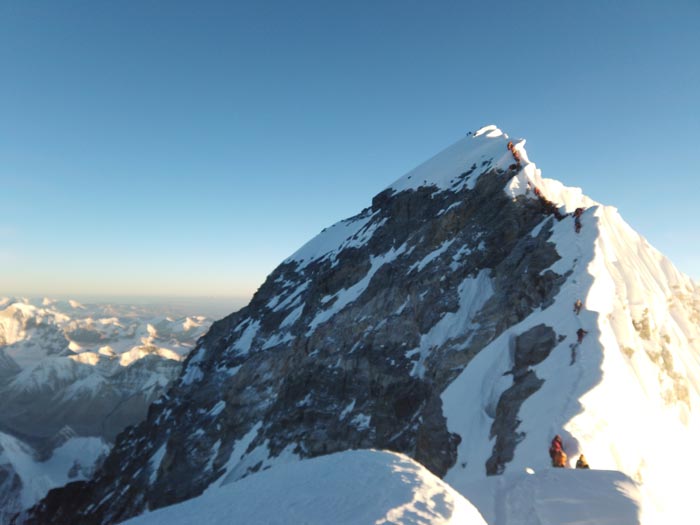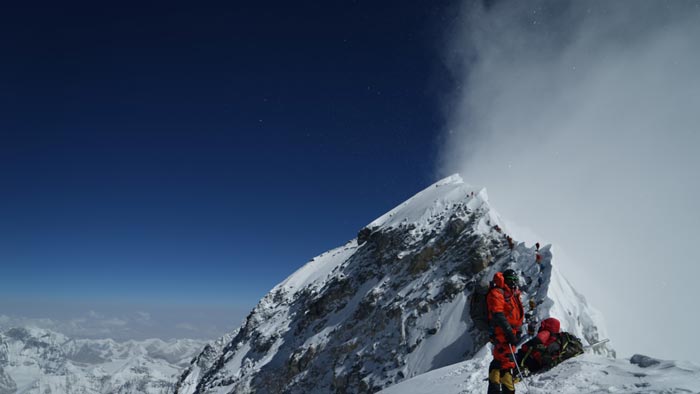KATHMANDU: Reports that at least 11 people died on Mt Everest due to crowding or widely termed as ‘traffic jam’ have been mere speculation. Government officials have dismissed claims that the deaths on Mt. Everest were caused due to over-crowdedness.
Gyanendra Shrestha, government’s liaison officer, who spent the whole climbing season this year at Everest Base Camp (EBC) refutes such reports. “The Everest witnessed a crowd this year due to the short and brief weather window. But the traffic, as rumored, didn’t claim a single life,” he told Khabarhub.
A large number of deaths of climbers on the Mount Everest this season is not solely due to the “traffic jam” on the world’s highest peak, the Nepal government claimed on Thursday, citing factors like high altitude sickness, other health reasons, and adverse weather.

In fact, the favorable climbing weather on the Everest deteriorated following the impact of the Cyclone Fani forcing the authorities to halt all mountaineering activities for at least two days.
Shrestha informed that the initial favorable weather this year was first on the 16th of May, while the second good weather to climb was from May 20 to 24.
This year the Everest 2019 Summit plan was as follows:
May 21: 122 people
May 22: 297 people
May 23: 172 people
May 24: Rest of the climbers
Pemba Dorjey Sherpa, who has already climbed the Mt Everest 20 times, denies the rumors of death caused by ‘traffic jam’ on Mt Everest. “Yes, there was congestion on the trail. However, this is not the reason for so many deaths,” he quips.
Pemba informed that all climbers keep waiting for the best weather to resume their climb. “This year we had quite a few days of good weather to climb. Since we usually do not postpone the climb, it created a jam for the whole world to see,” explains Pemba. However, he adds that they endeavored to manage while reducing the traffic on the Everest by dividing the number of climbers into different groups. “This strategy too didn’t go well as the number of climbers this year were significantly higher than previous years,” Pemba continues.
He claimed that a climber does not die due to what has been as publicized in a ‘traffic jam’ unless there is a stampede. Pemba likens it with snarl-ups on motorways or traffic jam on street ‘red light’. Ridiculing the much-hyped hypothesis of traffic-jam on the Everest causing several deaths, questions Pemba, “Does anyone die in the traffic on the streets? Yes, you might not be able to become the first one to reach the top but you won’t die.”
Pemba, who usually leads the climbers, adds further, “I am well accustomed to the nuts and bolts of climbing a mountain. Yes, there are other side effects — which I do not rule out — such as frostbite, cold infection in hands and fingers, snow bite, snow blindness, among others. However, these are not those factors that cause deaths.”
Pemba says the sudden change in the weather like a windstorm, glacier break, and ice fall could be the potential cause of death. We should identify other valid causes of deaths instead of projecting ‘traffic jam’ as the main cause”, suggests Sherpa.
Kanchi Maya Tamang, who, too, succeeded in climbing Mt Everest this year, disputes with the reports of deaths due to ‘traffic jam’.

Talking to Khabarhub, she revealed that the peak of tourist arrivals on Mount Everest is felt all through the spring season. However, this year, the number of climbers increased by several folds on May 22 and 23 — two days of the month as the weather turned good. “There was definitely a rush on those two days,” she recalls referring to the unprecedented instance that caused a traffic jam on the Himalayan trail of Mt Everest for the whole world to see. She, however, is not ready to agree that the death of the climbers was due to ‘traffic jam’.
HIV-infected Gopal Shrestha, 56, who ascended the Mt. Everest on May 22 this year, had to wait for two hours in the middle of the climb before he touched the peak from the South Col. Shrestha, too, did not see any deaths due to ‘traffic jam’ as has been widely reported.
Climber and a guide, Phurba Tenzing Sherpa, who has ascended Mt. Everest for 14 times, however, claims that the cause of the deaths was due to inexperienced guides and climbers, who do not have knowledge about Himalayan ecosystem and requirements.
He suggested the government authorities to fix the rope in the first week of May to minimize the crowd since climbers start climbing the mountains in the second week.
But only a couple of teams chose to climb then while the majority waited for the second window – from 22 to 24 May. Like others, Phurba, too, is not ready to agree that the ‘traffic jam; on the Everest caused so many deaths.
Consider what veteran climber and Everest expert Alan Arnette, who has studied the overcrowding issue for years, told Business Insider: “A limited number of days, too many people, too many inexperienced people, inadequate support — those things all came together and that’s where we saw most of the deaths.”
Most of those who died are believed to have suffered from altitude sickness, which is caused by low amounts of oxygen at high elevation and can cause headaches, vomiting, shortness of breath and mental confusion, summitters told Khabarhub.
Reasons behind the death in the Himalayas, according to mountain experts:
Inadequate training
Climbers’ inexperience (don’t know what you don’t know)
Inadequate support (running out of oxygen, unclipping from the fixed rope, etc.)
Ignoring AMS signs and not turning back
Hidden health issues (weak heart, aneurysm, etc.)
Wrong place, wrong time (avalanches, etc.)
Summit fever driving poor decision-making
Bad weather (mainly high winds and frostbite)
Few summit windows forcing people to go on the same day
How did the rumor go?
On May 23, climber Nirmal Purja tweeted an image of a crowd atop Everest’s Hillary Step, near the summit. Subsequent, the news coverage of the photo, as well as the rise in deaths, suggested overcrowding was disproportionately to blame for this year’s death toll.
Here’s what he tweeted:
Nims summited Mt Everest at 05:30 am and Mt Lhotse at 15:45 pm despite heavy traffic on May 22, 2019, Wednesday. As a source said, Nirmal Purja wanted to break his own record of the fastest record of 10 hours 15 minutes for Mt Everest and Mt Lhotse, but due to the traffic, he could not beat own records. Later on, Mingma Dorchi Sherpa, 32, breaks his record climbing Mt Everest and Mt Lhotse on May 27 within 6 hours 1 minute.
#ProjectPossible update. I summited Everest at 0530 and Lhotse at 1545 despite heavy traffic. I am now at Makalu base camp. Will be going directly for summit push from base camp. I will update once Makalu is complete. Thank you for my support especially my sponsors. pic.twitter.com/mAiLTryEln
— Nimsdai (@nimsdai) May 23, 2019
Later, many national and international media rumored about the number of people dying on the Everest referring his photo of ‘Traffic Jam’.
On June 3, he posted on Instagram denying the death of climbers due to ‘traffic jam’. Here’s what he posted: “Certainly there has been a lot of debates, critics, and the blaming games about this pic which I took on Everest this year….. I was there managing the traffic for almost 90 minutes. Point to note, nobody lost their life or had any issues whilst we were there.’
Who died when?
| May 16 | Everest | Seamus Sean Lawless | 39 | Irish | Crevasse Fall | |
| May 17 | Everest | Ravi Thakar | Indian | Altitude Related | ||
| May 22 | Everest | Anjali S Kulkarni | 54 | Indian | Altitude Related | |
| May 22 | Everest | Don Cash | 54 | American | Health (heart attack) | |
| May 23 | Everest | Kalpana Dash | 52 | Indian | Altitude Related | |
| May 23 | Everest | Ing ‘ Ernst’ Landgraf | 65 | Swiss | Health (heart attack) | |
| May 23 | Everest | Nihal Bagwan | 25 | Indian | Altitude Related | |
| May 24 | Everest | Kevin Hynes | 56 | Irish | Altitude Related | |
| May 24 | Everest | Dhruba Bista | 32 | Nepali | Altitude Related | |
| May 25 | Everest | Robin Haynes Fisher | 44 | British | Altitude Related | |
| May 27 | Everest | Christopher Jon Kulish | 61 | American | Health (heart attack) |
By looking at the above table, it is evident that only 2 people have been killed on May 22.
How many permits are issued for Mt Everest?
2019: Department of Tourism (DoT) had issued expedition permits to a total of 381 climbers. Out of 381, only 281 climbers along with 378 high-altitude workers successfully summited Mt Everest this spring. (11 climbers died on the Everest)
2018: DoT issued 346 Everest climbing permits (5 died)
2017: DoT issued 366 members of 39 different expedition groups to scale the 8,848-metre summit. (5 died)
2016: DoT issued 289 climbing permits from 34 groups. (6 died)
Statistically, Mt. Everest is becoming safer primarily due to better gear, weather forecasting, and more people climbing with commercial operations,” says Alan Arnette.
“From 1923 to 1999: 170 people died on Everest with 1,169 summits or 14.5 percent. But the deaths drastically declined from 2000 to 2018 with 7,990 summits and 123 deaths, or 1.5 percent.”
Likewise, The Department of Tourism (DoT) has claimed that high-altitude sickness and other health reasons caused deaths on Mt Everest this spring season, not congestion.

“Our attention has been drawn to the wrong information about deaths on Everest conveyed by national and international media,” said Dandu Raj Ghimire, director general of DoT, adding ‘traffic jam’ did not cause deaths on Mt Everest.
According to Ghimire, the post-mortem reports of the deceased climbers have shown that they died due to high altitude sickness, weakness or adverse weather conditions.
In a statement issued on Monday, the DoT has stated that it had issued 366 expedition permits in 2017 and 346 expedition permits for Mt Everest in 2018 — not a huge difference compared to 381 permits issued this year for the highest peak.

“Hence, it is untrue that congestion killed the climbers on Mt Everest and we urge everyone not to be swayed by false information,” reads the statement.
Ghimire also expressed his dissatisfaction at the dissemination of such ‘wrong’ information in the international media.
“Such false news tarnishes our image and affects our mountaineering sector. Therefore, everyone should think twice before passing such misleading messages in the international platform,” he added.









Comment